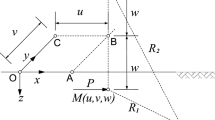Abstract
The construction of braced excavations in urban areas requires control of surrounding ground movements since excessive ground movements damage adjacent properties. Reasonably good amount of work on numerical analysis and field studies on the estimation of ground surface settlement adjacent to excavation have been reported in the literature. However, theoretical studies or mathematical modeling have not been well addressed in the literature. This paper presents a simplified design approach for estimation of wall deflection where diaphragm wall is assumed as continuous beam. Earth pressure in the backfill side is taken as load, exerted on the beam and strut load along with earth pressure in cut side represents support of the beam. Peck’s earth pressure diagram for braced wall is used for load calculation while Terzaghi’s equation is considered to derive coefficient of modulus of subgrade reaction. Applicability of the proposed approach has been verified by comparing the estimated values of wall deflection with the measured values of three different case studies.










Similar content being viewed by others
Abbreviations
- D :
-
Depth of wavelength or depth of fixity
- d :
-
Depth of embedment of wall
- H :
-
Depth of excavation
- M i :
-
Bending moment at point i of wall
- R :
-
Reaction force exerted by soil on wall
- h :
-
Space between two flexible supports
- K i :
-
Modulus of subgrade reaction of soil at point i
- γ :
-
Unit weight of soil
- c u :
-
Undrained cohesion of soil
- B 1 :
-
Size of plate used for plate load test (normally 0.3 m)
- B :
-
Size of foundation
- E S :
-
Modulus of elasticity of soil
- SF :
-
Factor of safety
- q a :
-
Allowable bearing capacity
- a :
-
Subgrade modulus at soil surface
- b :
-
Coefficient of subgrade modulus for depth variation
- α :
-
Exponent to give K value, the best fit
- E :
-
Modulus of elasticity of wall member
- I :
-
Moment of inertia of wall
- m :
-
Coefficient of deflection including soil modulus terms
References
Som NN, Raju IRK (1989) Measurement of in situ lateral stresses in normal calcutta deposit. In: Proceedings of the 12th ICSMFE’89, Rio-de-Janeiro, Brazil, vol 3, pp 1519–1522
Clough GW, O’Rourkee TD (1990) Construction induced movements of in situ walls. In: Proceedings of the ASCE conference on design and performance of earth retaining structures, Geotechnical special publication no. 25, ASCE, New York, pp 439–470
Ukritchon B, Whittle AJ, Sloan SW (2003) Undrained stability in braced excavations in clay. J Geotech Geoenviron Eng 129(8):738–755
Kung GTC, Juang CH, Hsiao ECL, Hashash YMA (2007) Simplified model for wall deflection and ground surface settlement caused by braced excavation in clays. J Geotechn Geoenviron Eng 133(6):731–747
Terzaghi K (1955) Evaluation of coefficients of subgrade reaction. Geotechnique 5(4):297–326
Tamaro GJ, Gould JP (1992) Analysis and design of cast in situ walls (diaphragm walls). In: Proceedings on retaining structures, Thomas Telford, London, pp 343–352
Pun WK, Pang PLR (1995) Horizontal subgrade reaction for cantilevered retaining wall analysis. Geo report no. 21, Geotechnical Engineering Office, Civil Engineering Department, The Government of Hongkong, Special Administrative Region
Peck RB(1969) Deep excavation and tunnelling. State of the art report. In: Proceedings of the 7th ICSMFE, Mexico, vol 3
Som NN (1991) Performance study of braced cuts for Calcutta Metro Construction. In: Proceedings of the 9th Asian regional conference on SMFE, Bangkok, vol 2, pp 387–394
Clough GW, Reed MW (1984) Measured behavior of braced wall in very soft clay. J Geotech Eng 110(1):1–19
Thasnanipan N, Maung AW, Tanseng P, Wei SH (1998) Performance of a braced Excavation in Bangkok Clay. Diaphragm wall subject to unbalanced loading conditions. In: Thirteenth Southeast Asian geotechnical conference, Taipei, Taiwan, ROC, pp 655.5–660.5
Lambe TW (1970) Braced excavations. In: Proceedings of the spec. conf. lateral stresses in the ground and design of earth retaining structures’70, Ithaca, NY, pp 149–218
Bolton MD, Osman AS (2006) Ground movement predictions for braced excavations in undrained clay. J Geotech Geoenviron Eng 132(4):465–477
Bowles JE (1968) Foundation analysis and design. Int. Student Edition, McGraw-Hill, New York
Vesic AB (1961) Bending of beams resting on isotropic elastic solid. In: Proceedings of the ASCE. J Eng Mech Div 87(EM2):35–53
IS 2911 (2010) Code of practice for design and construction of pile foundations. Part 1, Section 4, Bureau of Indian Standards, New Delhi
Author information
Authors and Affiliations
Corresponding author
Rights and permissions
About this article
Cite this article
Dan, K., Sahu, R.B. A Simplified Approach for Estimation of Braced Wall Deflection During Excavation in Soft Clay. Indian Geotech J 46, 56–63 (2016). https://doi.org/10.1007/s40098-015-0150-x
Received:
Accepted:
Published:
Issue Date:
DOI: https://doi.org/10.1007/s40098-015-0150-x




